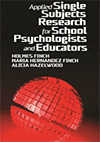
Applied Single Subjects Research for School Psychologists and Educators
By:
Holmes Finch, Ball State University
Maria Hernandez Finch, Ball State University
Alicia Hazelwood, Ball State University
Published 2021
This book will be written primarily for graduate students, advanced undergraduates, and professionals in the fields of school psychology, special education, and other areas of education, as well as the health professions. We see the book as being a viable textbook for courses in research design, applied statistics, applied behavioral analysis, and practicum, among others. We would not assume of the readers any prior knowledge about single subjects designs, nor any prior statistical experience. We will provide an introductory chapter devoted to basic statistical concepts, including measures of central tendency (e.g., mean, median, mode), measures of variation (e.g., variance, standard deviation, range, inter-quartile range), correlation, frequency distributions, and effect sizes. In addition, given that the book will rely heavily on R software, the introductory chapter will also devote attention to the basics of using the software for organizing data, conducting basic statistical analyses, and for graphics. The R commands used to carry out these analyses will be largely automated so that users will only need to define the range for their data, and then enter it into the R spreadsheet. We envision these tools being available on the book website, with instructions for using them available in the book itself.
We envision the book as being useful either as a primary text for a course in educational research designs, school psychology practicum, applied behavioral analysis, special education, or applied statistics. We also anticipate that individuals working in schools, school districts, mental health facilities, hospitals, applied behavioral analysis clinics, and evaluation organizations, as well as faculty members needing a practical resource for single subject design research, will all serve as a market for the book. In short, the readership would include graduate students, faculty members, teachers, psychologists, social workers, counselors, medical professionals, applied behavioral analysis professionals, program evaluators, and others whose work focuses on monitoring changes in individuals, particularly as the result of specific treatment conditions.
We believe that this book could be marketed through professional organizations such as the American Educational Research Association (AERA), the National Association of School Psychologists, the National Association of Special Education Teachers, the Association for Professional Behavior Analysis, the American Psychological Association (APA), the Association for Psychological Science, and the American Evaluation Association. Within AERA, the following special interest groups would have particular interest in this book: Action Research, Classroom Observation, Disability Studies in Education, Mixed Methods Research, Qualitative Research, and Special Education Research. The book could also be marketed to state departments of education and their special education and school psychology divisions. Currently, many state departments of education require documentation for Response to Intervention (RtI) and Multi-Tiered Systems of Support (MTSS) procedures for individual students. The method taught in this proposed book would allow educators and student support personnel to document the effectiveness of interventions systematically and accurately.
CONTENTS
CHAPTER 1: Introduction to Single Subjects Research Designs. CHAPTER 2: Basic Statistical and Computational Concepts. CHAPTER 3: Designing Single Subject Studies. CHAPTER 4: Graphical Exploration of Single Subjects Design Data. CHAPTER 5: Descriptive Measures Used in Single Subject Research. CHAPTER 6: Hypothesis Tests and Regression Based Models for Single Subject Research. CHAPTER 7: Small-N designs. CHAPTER 8: Full Example of Single Subject Design and Analysis. References.
-
Paperback978-1-64802-494-8
Web price: $45.04 (Reg. 52.99)
-
Hardcover978-1-64802-495-5
Web price: $80.74 (Reg. 94.99)
- eBook978-1-64802-496-2

- EDU009000 - EDUCATION: Educational Psychology
- PSY030000 - PSYCHOLOGY: Research & Methodology
- PSY032000 - PSYCHOLOGY: Statistics
-
 Farewell to Variables
Farewell to Variables
-
 Flourishing in Contexts and Cultures
Sociocultural Perspectives on Fostering Youth Well-Being
Flourishing in Contexts and Cultures
Sociocultural Perspectives on Fostering Youth Well-Being
-
 Hope for the Embattled Language Classroom
Pedagogies for Well-Being and Trauma Healing
Hope for the Embattled Language Classroom
Pedagogies for Well-Being and Trauma Healing
-
 Real Talk
Promoting Social Justice in Education and Psychology Through Difficult Dialogues
Real Talk
Promoting Social Justice in Education and Psychology Through Difficult Dialogues
-
 Teaching Human Development for Educators
Teaching Human Development for Educators
-
 Teaching Learning for Effective Instruction
Teaching Learning for Effective Instruction
-
 Ten Years of Idiographic Science
Ten Years of Idiographic Science

